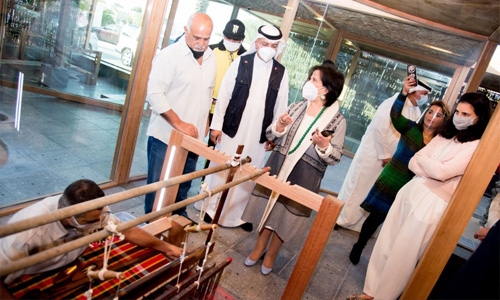Bani Jamra gets new textile factory
TDT | Manama
The Daily Tribune – www.newsofbahrain.com
Textiles from Bani Jamrah, pottery from Ali and Alsaffa and baskets from Karbabad, each town and village in the Kingdom have a different tale to tell when it comes to traditional arts and crafts.
Despite immersed in the power of oil trade, the scattered island kingdom, one could see, is filled to its brim with ancient history dating back more than 4,000 years.
However, in these days of oil and cloud-based tech, getting a real sense of that heritage is not easy.
“But not anymore,” says the Authority for Culture and Antiquities here in the Kingdom.
The authority has managed to take a walk back into that history, to revive a tradition passed by generations for over 3,000 years.
The newly inaugurated “Bani Jamra Textile Factory” or the “Naseej Factory” offers a glimpse into that glorious past.
Before the discovery of oil, Bani Jamra was a shining gem.
It was well-known as a centre of traditional fabric weaving and its exquisite weaving technique.
Experts say the technique involved two distinct sets of wool, interlaced to create a pattern, which is both intricately detailed and vibrantly coloured.
The new “Bani Jamra Textile Factory” or the “Naseej Factory” designed by Leopold Banchini seeks to revive this tradition. The factory, designed to look like a “barasti” - Palm tree branches provide shades for the spinning and weaving activities native to the village of Bani Jamrah while acknowledging their informal nature.
The factory houses sections to make textiles, and for training and apprenticeship.
It also accommodates facilities like cafeteria, and textile handicraft shop for weavers to sell their products.
The project works as a community centre, and play area for the whole village.
Working on looms in Bani Jamrah and Jasra are Bahrain’s fabric weavers who had inherited the trade from their fathers and their forefathers.
The produce lengths of cloth to turn them to irdeh, a black abbaya with lines of red and gold worn by women from rural areas, or the well-known wezar, worn around the waist by men.
“Today, the craftsmen produce a multitude of items. In addition to traditional wear, scarves in varying colours are available for customization. While weaving, the craftsmen use both his hands and legs and distributing and overlapping the threads into each other in a systematic and coordinated manner,” explains a ministry report.
It is also worth noting that most of the managers and staff at the village are craftsmen themselves.
The facility was inaugurated on Wednesday by Sheikha Mai Bint Muhammad Al Khalifa, the President of Bahrain Authority for Culture and Antiquities, and Northern Governor Ali bin AlSheikh Abdul Hussein Al-Asfoor.
The project seeks to enhance the Kingdom’s economic development and its position as a regional and international cultural and historical centre. The factory is open to visitors from Saturday to Thursday, from 8 am-1 pm and 3 pm-5 pm.
Related Posts

